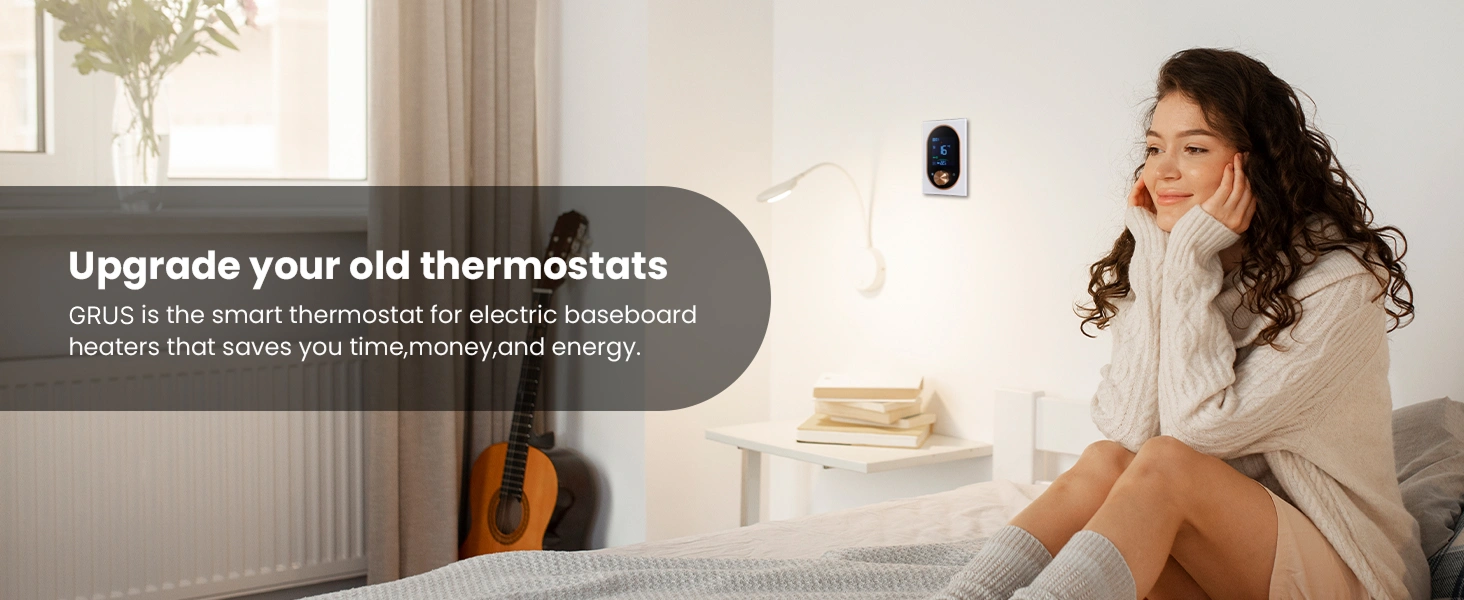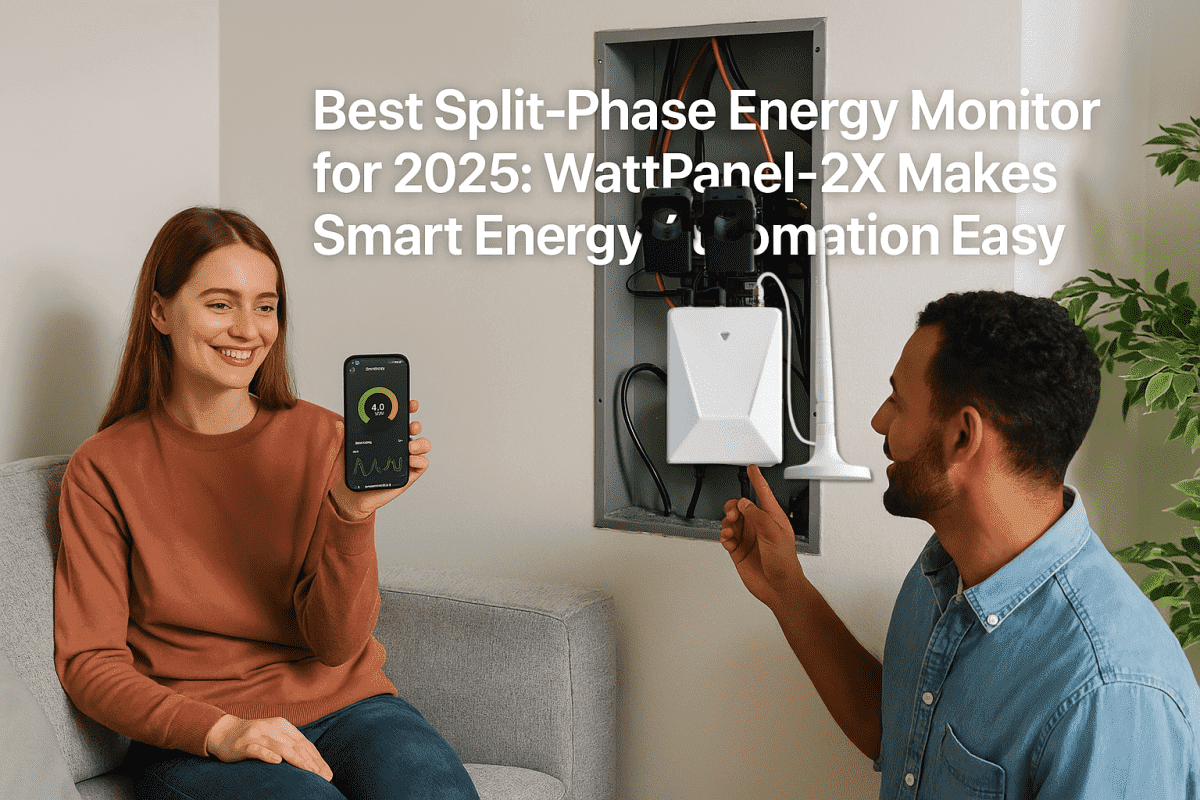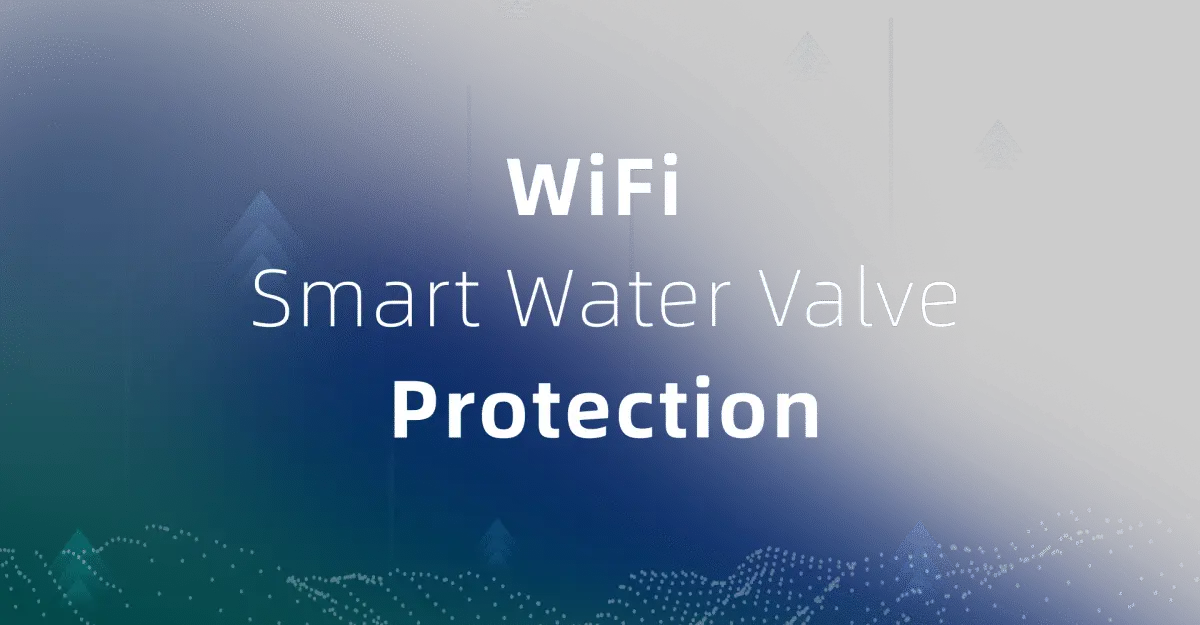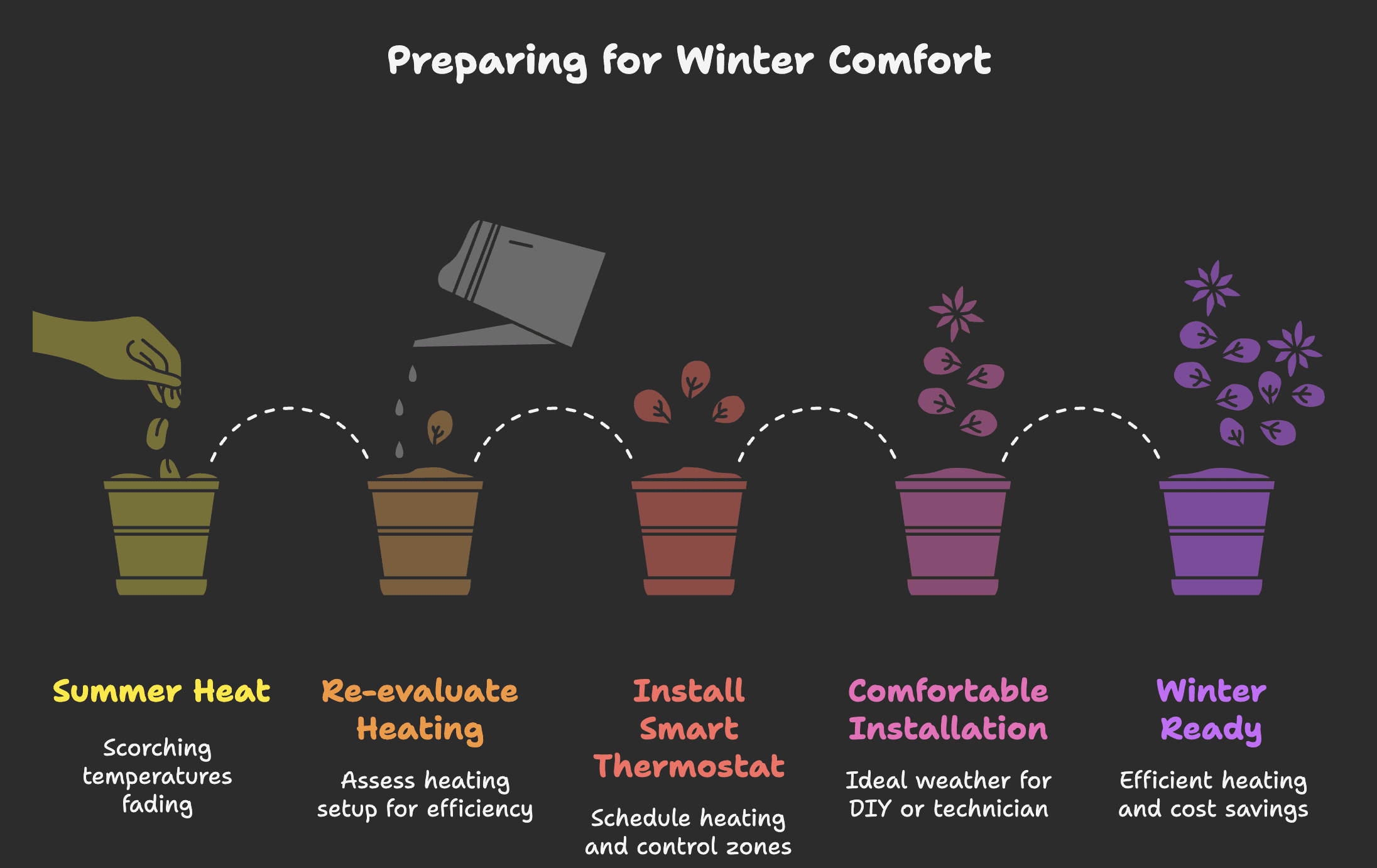
Lorsqu'il s'agit de choisir entre un thermostat programmable et un thermostat intelligent,many homeowners with baseboard heaters wonder if the upgrade is really worth it. If you already use a programmable model, you’re ahead of most — but as energy costs rise, a smart thermostat could take you the rest of the way.
You’ve taken that first step toward saving energy — but as utility bills keep climbing, you might be wondering:Le passage à un thermostat intelligent ferait-il réellement une différence ?
It’s a fair question. Programmable thermostats have been around for decades, and they work just fine. But modern smart thermostats promise more comfort, more control, and better savings. Are they truly worth upgrading for? Let’s look at how both types work, how much they really save, and which one fits your home best.
1. Pourquoi de nombreux propriétaires se lassent de leurs thermostats programmables
Programmable thermostats were designed to help homeowners save by scheduling heat around daily routines. You set a weekly schedule — warm in the morning, lower while you’re at work, cozy again by evening. In theory, it’s perfect.
In reality, life isn’t that predictable anymore. Between hybrid work, weekend plans, or kids’ activities, few families actually stick to fixed schedules. And that’s where things fall apart.
“I had a basic Honeywell for years,” one user wrote. “It worked fine — until my routine started changing. Then I was constantly reprogramming it or forgetting to change the schedule. My ‘automatic’ system became completely manual.”
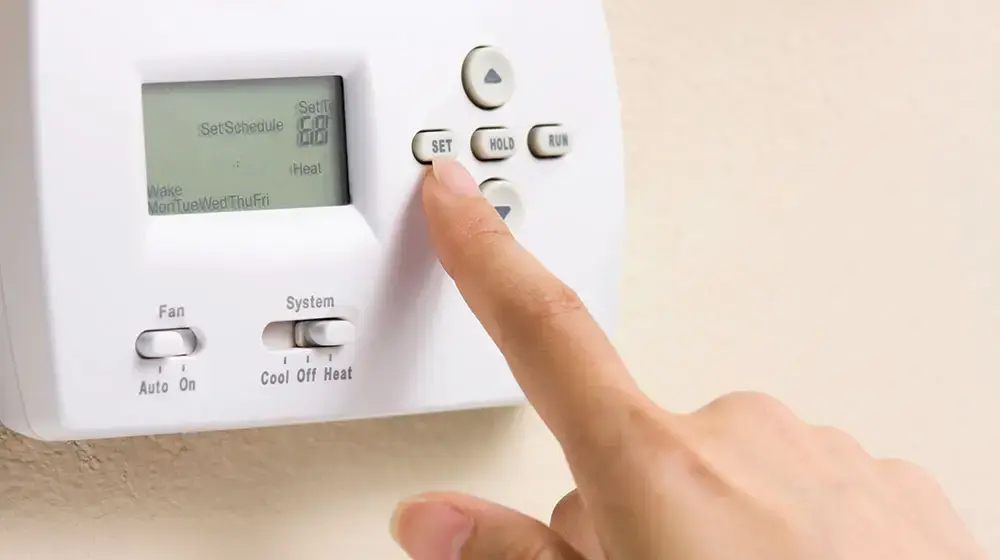
If your thermostat is still following an outdated schedule, you’re probably wasting energy without realizing it. Many households eventually give up adjusting altogether and just keep one temperature all day.
Donc oui, les thermostats programmablescanbe energy saving thermostats — but only if you keep programming them. And let’s be honest, most of us don’t have the patience for that every week.
2. Qu’est-ce qui rend un thermostat véritablement « intelligent » ?
Les thermostats intelligents vont bien au-delà des minuteries et des programmes manuels.apprendre,adapter, etoptimiserautomatiquement.
Voici ce que cela signifie en pratique :
- Contrôle Wi-Fi et applications– You can check or adjust the temperature from anywhere using your phone. No need to run downstairs or back home to turn the heat off.
- Mode d'apprentissage– The thermostat recognizes your patterns over time, adjusting heat automatically for your comfort while minimizing waste.
- Géorepérage– When you leave home, the temperature drops automatically. When you’re heading back, it warms up again before you arrive.
- Contrôle vocal– Compatible avec Alexa et Google Home, vous pouvez donc dire : « Baisse le chauffage à 68. »
- Rapports sur l’énergie– De nombreux thermostats intelligents suivent la consommation, vous permettant de voir exactement quand et où l'énergie est gaspillée.
Unlike programmable thermostats that need your input, smart models handle the details for you. You stop guessing — and your system starts saving.
Pour les propriétaires utilisant des plinthes chauffantes électriques, des produits comme leThermostat intelligent EcoNet-BHIntégrer ces mêmes fonctionnalités intelligentes aux systèmes de chauffage à haute tension.
“It’s one of those small upgrades that actually changes how you live,” said another reviewer. “Now I can check every room’s temperature from my phone, even at the cabin.”
Ce confort se traduit rapidement par une réelle efficacité énergétique.
3. Économies d'énergie concrètes : privilégier les faits au marketing
Passons aux faits, au-delà des chiffres marketing.
Selon leDépartement de l'énergie des États-Unis, en utilisant correctement un thermostat programmable, on peut économiser environ5–8%sur les factures de chauffage et de climatisation. Athermostat intelligent, par comparaison, permet généralement d'économiser10–20%par année.
Cela peut paraître peu, mais considérez les dépenses moyennes des ménages nord-américains.$800–$1,200une année de chauffage. Une réduction de 15 % équivaut à environÉconomies de 120 à 180 $ chaque hiver— suffisamment pour amortir la mise à niveau en une ou deux saisons.
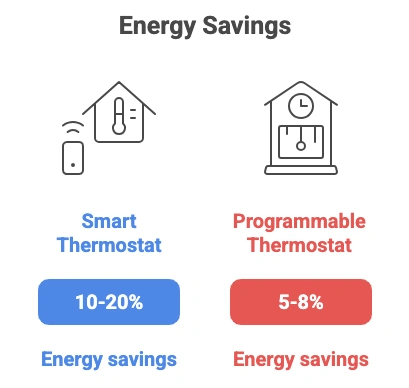
Voici un bref récapitulatif :
| Fonctionnalité | Programmable | Intelligent |
|---|---|---|
| Contrôle | Horaires quotidiens fixes | Application, apprentissage, géorepérage |
| Rapports sur l’énergie | ❌ Aucun | ✅ Rapports d'utilisation détaillés |
| Épargne (moyenne) | 5–8% | 10–20% |
| Facilité d'utilisation | reprogrammation manuelle | Entièrement automatique |
| Commodité | Basique | Haut |
Those savings come from fewer wasted hours of heat when no one’s home, plus better temperature consistency. You won’t find yourself roasting one room and freezing in another just because the schedule didn’t match your day.
En bref : les thermostats intelligents ne se contentent pas d’économiser de l’électricité, ils permettent aussi d’économiser de l’argent.attentionUne fois installées, elles fonctionnent discrètement en arrière-plan pour réduire les déchets au quotidien.
4. Un thermostat intelligent est-il adapté à vos radiateurs plinthes ?
Voici le point important : tous les thermostats intelligents ne sont pas compatibles avec le chauffage par plinthes.
La plupart des modèles populaires que l'on trouve dans les grandes surfaces (comme Nest ou Ecobee) sont conçus poursystèmes de fournaises basse tension- pasradiateurs électriques à tension de ligneSi vous branchez un appareil du mauvais type, il ne fonctionnera pas correctement, voire pourrait même s'avérer dangereux.
Avant de procéder à la mise à jour, vérifiez trois points :
- tension:Les radiateurs plinthes fonctionnent généralement sur des circuits de 120 V ou de 240 V.
- Câblage :Make sure your existing thermostat has two or four thick wires — that’s a sign it’s line-voltage.
- Compatibilité:Choisissez un thermostat intelligent pour plinthe chauffante, conçu spécifiquement pour ce type de système.
C'est là queEcoNet-BHcomes in. It’s built for electric baseboard and radiant heating systems common in older and modern North American homes alike.
Il se connecte viaWi-Fi (Grus App), soutientCommande vocale Alexa et Google Homeet comprendsix périodes programmables par jour— vous offrant la flexibilité d'un thermostat programmable, et l'intelligence d'un thermostat intelligent.
“We installed the EcoNet-BH upstairs last winter,” said one customer. “Finally, the rooms stay warm when we’re home and cool when we’re not — and I can see the energy difference right on my phone.”
C’est le genre de confort que l’on peut ressentir — et mesurer.
5. Pourquoi la mise à niveau est judicieuse au-delà des chiffres
For many homeowners, the real value isn’t just saving on heating bills — it’s comfort and peace of mind.
Les thermostats intelligents vous permettent de :
- Vérifiez la température de votre maison à des kilomètres de distance ;
- Préchauffez la pièce avant votre arrivée ;
- Surveillez votre consommation d'énergie en temps réel ;
- Maintenir un confort constant dans plusieurs zones.
Ils sont particulièrement pratiques pour :
- maisons de vacances ou locations– la télécommande évite le gaspillage d'énergie lorsqu'elle est inoccupée ;
- Chambres à l'étage ou au sous-sol– gérer facilement les zones de chaleur inégales ;
- Familles occupées– L’automatisation « paramétrable et sans oubli » s’adapte aux horaires imprévisibles.
With more homeowners moving toward smart energy efficiency, the upgrade isn’t about luxury — it’s about future-proofing your comfort and cutting avoidable waste.
EcoNet-BH — Commande intelligente conçue pour les radiateurs plinthes
Si votre maison utilise des plinthes chauffantes,EcoNet-BHest conçu spécialement pour vous.
- Conçu pour les systèmes à tension de ligne de 120/240 V
- SupportsContrôle via application Wi-Fivia Tuya Smart
- Fonctionne avecAlexa et Google Home
- Comprendplanification programmable sur 6 périodes
- Hasmodes d'économie d'énergie et manuels
- Nécessitepas de centre névralgiqueet s'installe facilement
Whether it’s your main residence, a rental unit, or a lakeside cottage, EcoNet-BH gives you the flexibility to stay warm efficiently — without wasting a single watt.
Découvrez les spécifications complètes et les conseils d'installation sur leThermostat intelligent pour plinthe chauffante EcoNet-BH.
Conclusion : Quand commodité et efficacité se rencontrent
If your programmable thermostat still works, there’s no rush to toss it out. But if you want a system that adjusts automatically, learns your habits, and finally helps youseePour réaliser des économies d'énergie, passer à un thermostat intelligent est une démarche simple et rentable.
For baseboard heater homes especially, the difference is night and day — fewer wasted hours, lower bills, and a home that’s always the right temperature when you walk in.
Prêt pour une maison plus confortable et plus efficace ?
Voyez commentThermostat intelligent pour plinthe chauffante EcoNet-BHVous aide à rester au chaud, à économiser davantage et à simplifier votre confort cet hiver.
Si vous souhaitez découvrir comment la régulation intelligente de la température s'intègre à un système pour toute la maison, visitez notre site web.Solution de contrôle de température à distance.
FAQ
Les thermostats intelligents permettent-ils réellement d'économiser plus d'énergie que les thermostats programmables ?
Yes — studies from the U.S. Department of Energy show smart thermostats can save around 10–20% on heating and cooling costs each year. They automatically adjust temperatures when you’re away, which prevents energy waste most programmable models can’t detect.
Puis-je utiliser un thermostat intelligent avec des plinthes chauffantes électriques ?
Not every smart thermostat works with baseboard systems. Most popular models like Nest or Ecobee are built for low-voltage HVAC systems. For electric baseboards (120V or 240V), look for aThermostat intelligent pour plinthe chauffanteConçu pour la tension secteur, il se connecte directement et en toute sécurité.
Est-ce que le passage d'un thermostat programmable à un thermostat intelligent en vaut vraiment la peine ?
If your goal is lower heating bills and less daily hassle, yes. Smart thermostats save energy automatically, show real-time usage data, and give you remote control through your phone or voice assistant. Most homeowners recover the cost within a winter or two.
